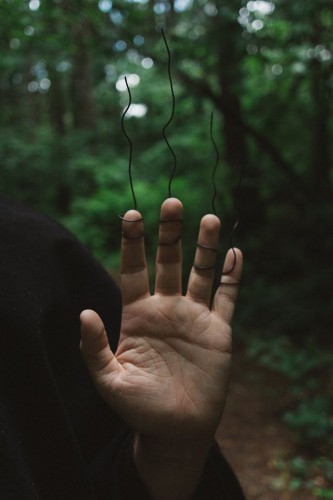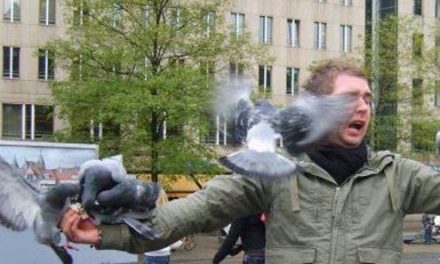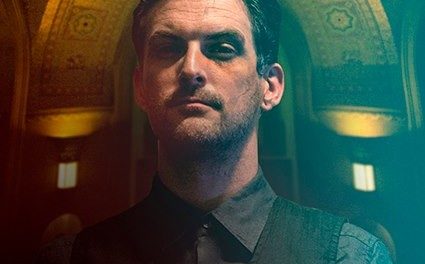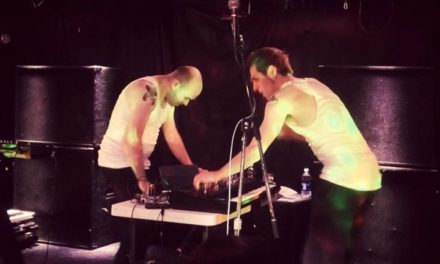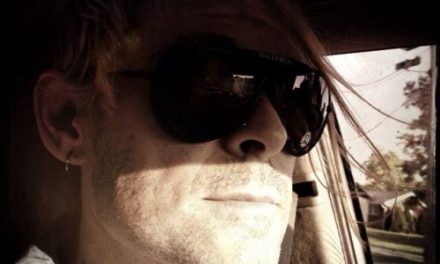Michael Kurt has applied some of the atmospherics and structures of the witch house diaspora into his main project [product] in the past, but The Blood of Others is his first full foray into that dark night. The debut album I Used to Think Everything Was Beautiful features as wide a palette of sampled instrumentation and synth work then we’ve yet heard from the Portland based producer, arranged in careful accompaniment to songs that bridge his work in industrial to any number of dark genres of music. We caught up with Michael to discuss the inspiration and construction of the album, and to get him to offer commentary on the origins and meanings of its ten songs.
“The songs that I enjoy most are the ones that hurt a little bit when you read the lyrics.”
ID:UD: The Blood of Others very much feels like it’s continuing to explore some of the post-witchhouse sounds you were using on the most recent [product] material. What was the thought process in starting a new project around those ideas?
Michael: The process of starting the new project all revolved around the first three songs that I wrote – which were originally [product] songs following up the Her Ghost EP – “The Thunder In My Heart Is Gone,” “To The Silent,” and “Trace To The Ashes.” Those songs had a pretty distinct sound that I wanted to explore that was noticeably different and, for me, had a lot of emotion attached. When I originally presented the songs to Vendetta Music, who [product] released Shallow Graves through, they weren’t super keen on the style. Luckily, about 6 months after that, I had the chance to present the same material to Audiotrauma and they were completely on board. They loved the sound and had a lot of great ideas for not only the sound, but starting a completely different project.
ID:UD: The mood of the record is very free-flowing, with a lot of nature imagery on display in the lyrics and song titles. Can you speak to where that comes from, and if those themes play into the instrumental construction of the songs?
Michael: In the past, with [product], I was aiming for a specific audience and place. With The Blood of Others, I really wanted to pull in all of the music and images that inspired me. Portland sits in the middle of many forests, mountains, beautiful lakes, and a crazy long rainy season (as I am sure you know well in Vancouver), and these things definitely seeped into the music and imagery. One of the many suggestions that Audiotrauma had while constructing the rest of the album was to include field recordings from the forest and surrounding areas to go with the theme of the lyrics. This pulled a lot of the elements of the album together for me. While the songs may vary in speed and feeling, these kinds of images and titles keep it pretty grounded in my intentions.
ID:UD: It feels like I Used to Think Everything Was Beautiful has a focus on using a variety of voices and deliveries to create different moods and narratives. Were you consciously trying to move away from being the singular vocal presence on this material?
Michael: Yes. One of the things that I set out to do with The Blood of Others was explore some of the things that I was missing with [product]. Cleaner singing, different vocal styles and delivery. The main thing for me was to include as much emotional charge as possible, which is something that Boris May from Klangstabil really helped me with. He is a brilliant lyricist, and person, and one of the main things that I took from working with him was to be as honest and emotional as I needed to be in the songs. The songs that I enjoy most are the ones that hurt a little bit when you read the lyrics. For me, this manifested in different ways for different tracks.
ID:UD: You’ve already started performing this material for audiences, using the same live line-up you have for [product] (Wes Mueller and Levi Pev). How has the transition from one project to the other worked in a live context? Do you approach your performance differently?
Michael: We tried to create The Blood of Others’ performance from scratch, from the video projections, which were made by Wes (and are a pretty vital part of the live set), to the way that we interact with each other. We had to examine everything and make it different. With [product], it was all about the energy and keeping people dancing. Getting in people’s faces. But The Blood of Others is more introspective and reserved. Less audience interaction and more visually dark, and hopefully impactful.
“When The Light Takes Us”
I wanted to start the album with a slow song, which was a little bit of an afterthought. “When The Light Takes Us” sets the tone for the entire album for me. It is slow, contains a lot of guitars, and kind of foreshadows the theme. Project Pitchfork’s album Inferno had a lot to do with this actually. The first track, “Momentum,” is slow and largely different from the rest of the album, but for some reason really sets the entire mood for how you listen to the album. “When The Light Takes Us,” as a title at least, is a small tribute to Burzum’s Hyvis Lyset Tar Oss. I don’t at all agree with the person behind Burzum, but the theme of this album and the imagery had a big impact on me when I was younger. So, I wanted to take that theme and put it in a more personal place. The sample at the end of the song, read by my partner Sophie, is from The Stranger by Albert Camus in its original French text. This quote, in English at the time, had a very large impact on me at a time when I was trying to figure things out.
“To The Silent”
This was the song that really sold Audiotrauma on agreeing to put the album out. It was actually the first song that I sent them, by itself, and they immediately had some ideas about the rest of the album and what they were looking for with the release. Aside from re-recording the vocals on a higher quality microphone, this song is largely in its original form. When I wrote this song, I was trying to explore a dark and slow place in my musical influences. Bands like Attrition and V▲LH▲LL had a lot to do with the sounds.
“The Thunder In My Heart Is Gone”
Written around the same time as “To The Silent,” this song was definitely one that I based the rest of the album around. It was the starting point of something very morose inside of me that I felt that I had to explore. It was written at a time when I was very unhappy with myself and the way that I saw the world around me. This was one of those songs that was written all in one day – music, lyrics, recording – and captures that time for me. The label had a few notes on the sounds and the vocal delivery, but this was one that I knew had to be left alone, for better or for worse. I tried, a few times actually, to re-record the vocals. I just wasn’t able to recapture the moment, which is why it sounds kind of breathy and weird in some spots. Sometimes you can’t force it.
“The Velvet Cloak of Darkness”
I have had instrumental songs on albums before, with [product], but with Audiotrauma I felt really comfortable making a noisier track that didn’t need vocals. This song was inspired by the Dive performance at Terminus two years ago. We actually perform this one live and it is a lot of fun.
“We Will Shine (feat. Boris May)”
I worked very closely with Boris on this track. I had been listening to a lot of Klangstabil at the time and decided to reach out to him for a guest spot on the album. He listened to the track a few times and then made me Skype with him a few times before finally agreeing to do it. Those Skype calls were some of the most inspirational experiences that I have had in this scene. He is a madman when it comes to lyrical concept and execution. He would constantly fill me in on recording sessions and how things were going. It was an amazing experience.
“Trace To The Ashes”
This was another song that was included in the first few tracks to come together for the album. I was really trying to do something different vocally with this one. The original mix that I submitted to the label had much cleaner vocals, but they suggested that I try something to make them fit better with the music and I am definitely happy I did. Arco [from audiotrauma and Chrysalide]’s mixing on this track really made it a different monster too. He put a lot into making this one well balanced.
“Midwinter Ritual”
Originally called “Sky Symbol Rituals”, this track was a super outrun jam that was a lot of fun but did not fit at all with the rest of the album. I basically changed out all of the instruments and scrapped the original drums to make this work. I might bust the original out some time for fun.
“The Word For World Is Forest”
This is, hands down, my favorite track to play live – I think that Wes would agree – because it just builds up to that last moment before dropping into a kind of classic [product]-style breakdown. The title of this song comes from the Ursula K. Le Guin book of the same name. There is an interesting idea in the book that stuck with me – the native people on the main planet believe that there are two worlds for every person: the world of the awake and the world of the dreaming. Admittedly, this is a small aspect of a much larger story about native people fighting against their colonizers, but the dream world would often allow the people to find peace in the living world, even in times of strain. This song is essentially about accepting death in the dreaming world to be at peace with it in reality.
“The Beacon”
This is another track that started off in a much different place. I submitted a more straightforward track, which when I look back now was a little uninspired, and the label could see that, I think. I took it back and basically changed most of the elements out (I reversed a lot of the parts and re-cut them) until it started to feel more aggressive and emotional. The guitar part in the break was what the song was centered on to begin with and I am happy that this stayed through all of the edits.
“I See Bad Spirits”
The title for this track comes from the first My Life With The Thrill Kill Kult album I See Good Spirits and I See Bad Spirits, which was a small inspiration for the music in this album overall. That title always stuck out to me and I wanted to include it in something because I feel like there are times when all you can see is the bad things, which is what this song is generally about. The spoken word verse in this song was something that I tried a lot of different ways – screaming, singing, whispering – but it just didn’t work. The chorus at the end kind of sums up the album and brings it to the conclusion that I wanted to communicate to the listeners.
The Blood of Others’ debut LP I Used to Think Everything Was Beautiful is out now via Audiotrauma.

